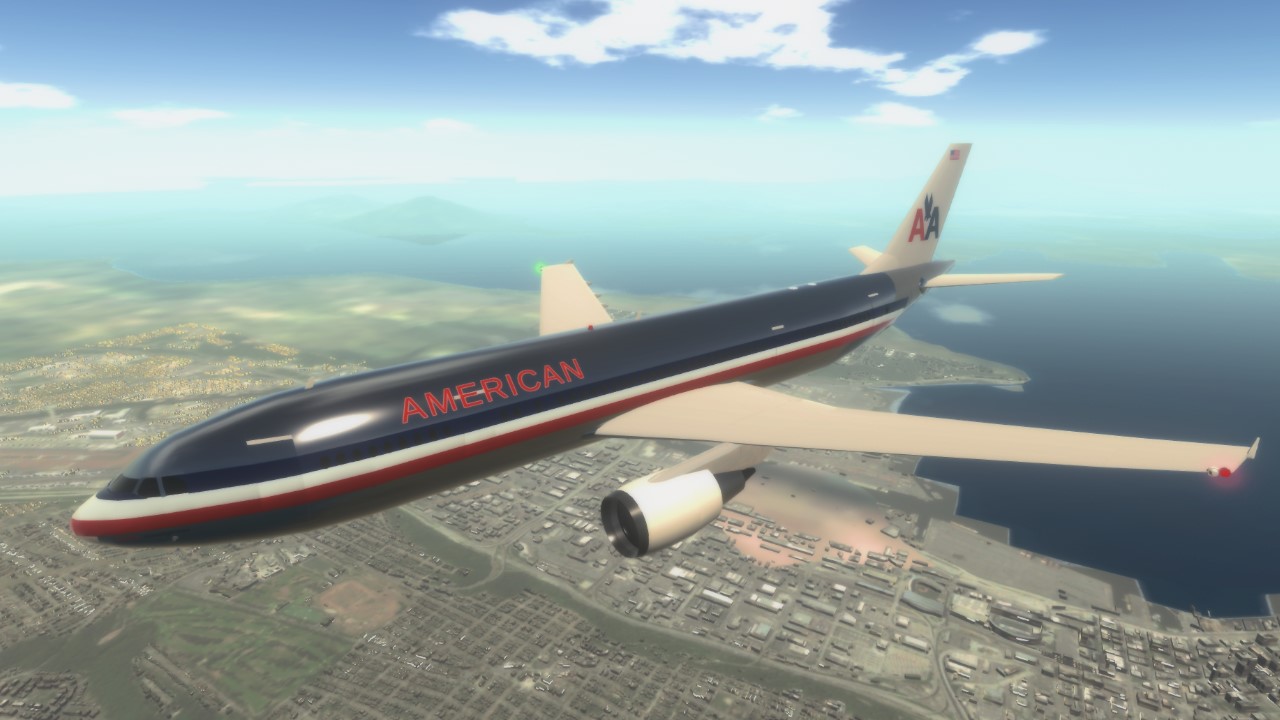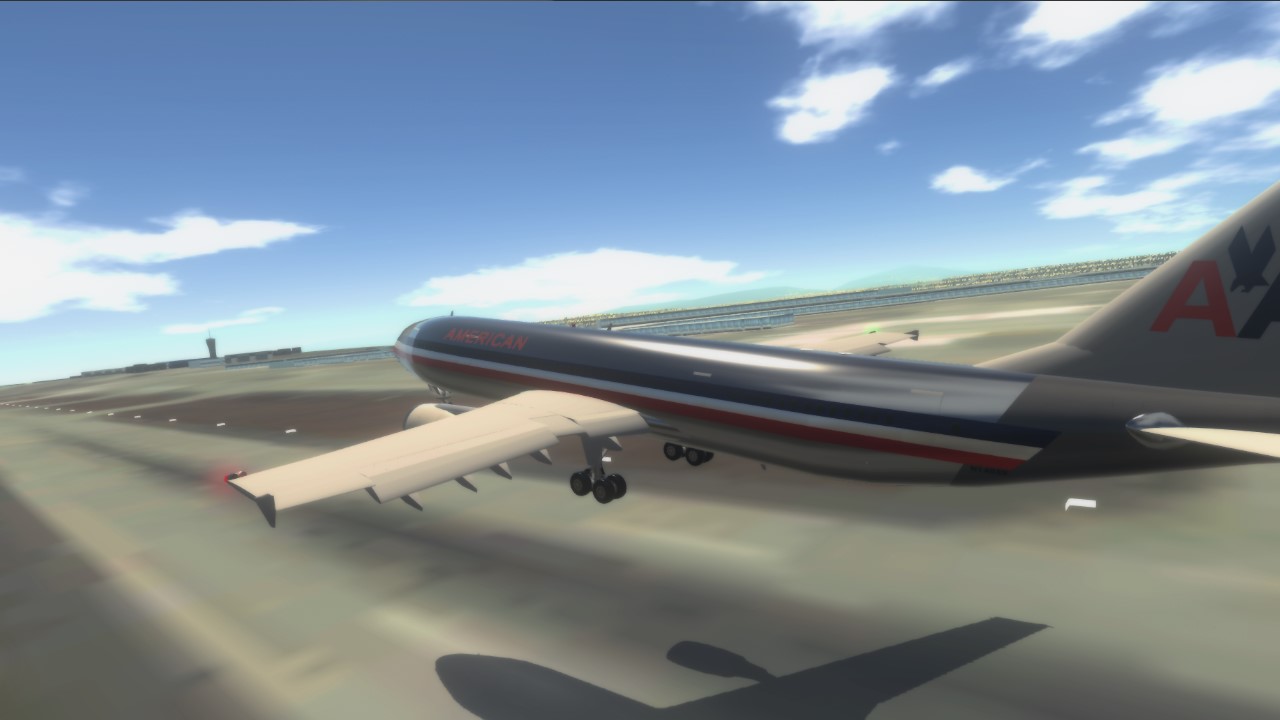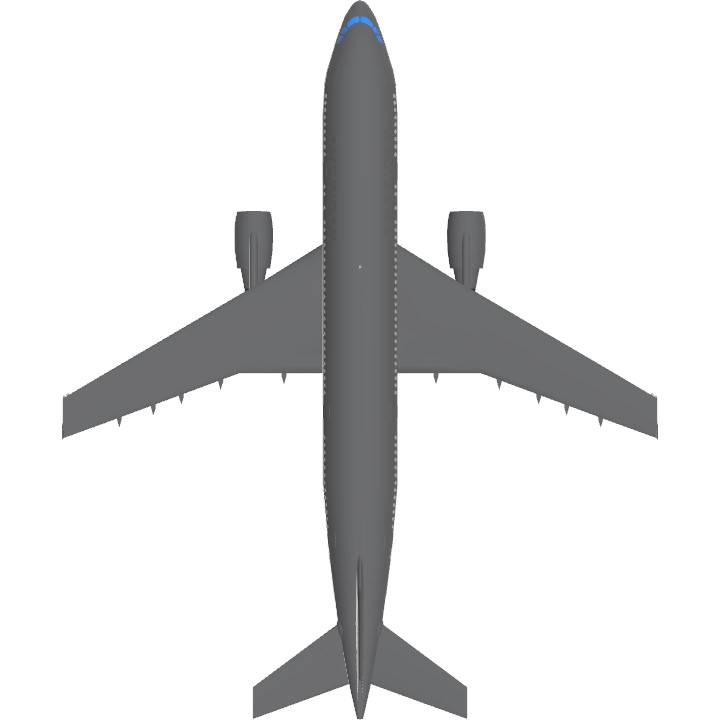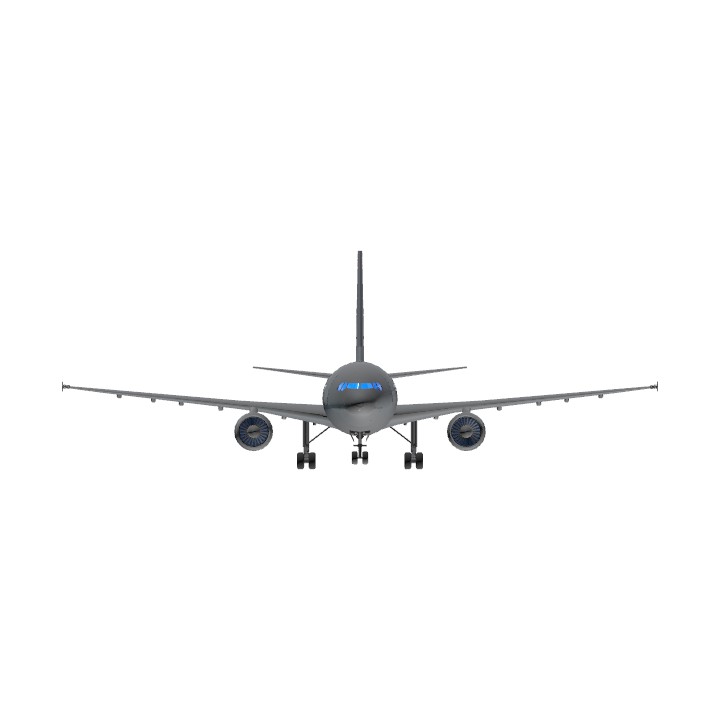Edit 10/30/24: I also regret posting this one
Oh great. Autocredit isn't working... again
Updated Paint Color Correction Version
Original Aircraft Credit goes to GalacticaAsia's A300-600GE
Thank you to SimpleplanesJP11 for providing the shader preset for the thumbnail.
Map used for thumbnail: Washington & BC by Annedzsrue
About the Airbus A300-600
The A300-600, an upgrade version of the original A300B series, was introduced after the A310 began commercial service in 1982. The A300-600, officially designated as the A300B4-600, was slightly longer than the A300B2 and A300B4 variants and had an increased interior space from using a similar rear fuselage to the Airbus A310 which allowed it to have two additional rows of seats. It was initially powered by Pratt & Whitney JT9D-7R4H1 engines, but was later fitted with General Electric CF6-80C2 engines, with Pratt & Whitney PW4056 or PW4058 engines being introduced in 1986. Other changes include an improved wing featuring a recambered trailing edges with the incorporation of simpler single-slotted Fowler flaps, the deletion of slat fences, and the removal of the outboard ailerons after they were deemed unnecessary on the A310. The variant made its first flight on July 8th, 1983, received certification on March 9th, 1984, and entered service in June of 1984 with Saudi Arabian Airlines.

The prototype A300-600 (Registration: F-WZLR) in flight at the 1984 Farnborough Airshow

The prototype, F-WZLR, was sold to Mexican charter airline La Tur in 1989 and registered as F-ODTK. From 1990 to 1991, the aircraft was leased to Garuda Indonesia, seen here at Melbourne Airport (IATA: MEL / ICAO: YMML) in November 1990

The first A300-600 to enter commercial service with operator Saudi Arabian Airlines (Registration: HZ-AJA) at King Abdulaziz International Airport (IATA: JED/ICAO: OEJN) on March 20th, 2006.
A total of 313 A300-600s were sold. The A300-600 uses the A310 cockpits which utilized electronic displays and eliminated the need for a flight engineer. Production of the A300 series ended in July of 2007 after 561 deliveries. A few are still in passenger service, mainly being used by Iranian based airlines such as IranAir and Mahan Air, whilst the rest have been converted to freighter use and carry cargo for airlines such as UPS Airlines, FedEx Express, and DHL.
A300-600 Specifications
Length: 177ft 5in / 54.08m
Height: 54ft 6.5in / 16.62m
Wingspan: 147ft 1in / 44.84m
Type Designation
ICAO: A306
IATA: AB6

The cockpit of a DHL European Air Transport A300B4-622R(F) (Registration: D-AEAP) at Budapest Ferenc Liszt International Airport (IATA: BUD/ ICAO: LHBP) on March 29th, 2019.

The cabin of a Lufthansa A300B4-605R (Registration: D-AIAY) at Frankfurt Airport (IATA: FRA/ICAO: EDDF) on June 14th, 2009.
About American Airlines
IATA Code: AA
ICAO Code: AAL
Callsign: AMERICAN
Primary Hub: Dallas Fort Worth International Airport (IATA: DFW/ICAO: KDFW)
Headquarters: Fort Worth, Texas
Years Active: 1926-Present

An American Airlines Convair CV-240 at LaGuardia Airport (IATA: LGA / ICAO: KLGA) on September 29th, 1957 painted in the original 'Flagship' livery. The Flagship livery was used from 1945-1968 and underwent many different small design alterations that I'm not gonna put here.

An American Airlines Boeing 707-123B, N7591A, at John Glenn Columbus International Airport (IATA: CMH / ICAO: KCMH) in March 1971, wearing the 'Astrojet' livery used from 1964-1968

An American Airlines Boeing 757-223, N651AA, sporting the old ‘Vignelli Eagle’ logo on the tail, wearing the iconic 'Bare Metal' livery which was worn on American Airlines aircraft from 1969-2013 at Miami International Airport (IATA: MIA, ICAO: KMIA) on October 12th, 1991. On December 20th 1995, this aircraft, operating as Flight 965 crashed into a mountain while on approach to Alfonso Bonilla Aragón International Airport (IATA: CLO / ICAO: SKCL) in Columbia, killing 159 of the 163 occupants aboard.

An American Airlines Boeing 787-8 (Registration: N818AL) wearing the airlines 'New American' livery at Amsterdam Airport Schiphol (IATA: AMS/ICAO: EHAM) on May 12th, 2024.
American Airlines is a major US-based airline and legacy carrier headquartered in Fort Worth, Texas, within the Dallas–Fort Worth metroplex. It is the largest airline in the world when measured by fleet size, scheduled passengers carried, and revenue passenger mile at the time of writing. American, along with various regional partners and affiliates operates an extensive international and domestic network with almost 6,800 flights per day across the globe. American Airlines is a founding member of the Oneworld alliance, the third-largest airline alliance in the world. Regional service is operated by independent and subsidiary carriers under the brand name 'American Eagle'.
American Airlines operates out of 10 hubs, with Dallas/Fort Worth being its largest. The airline handles more than a hundred million passengers annually with an average of more than 500,000 passengers daily. American Airlines was started in 1930 via a union of multiple small airlines. The two primary organizations from which American Airlines was originated were Robertson Aircraft Corporation and Colonial Air Transport. The former was first created in Missouri in 1921, with both being merged in 1929 into holding company 'The Aviation Corporation'. This, in turn, was made in 1930 into an operating company and rebranded as American Airways. In 1934, when new laws and attrition of mail contracts forced many airlines to reorganize, the corporation redid its routes into a connected system and was renamed American Airlines. Between 1970 and 2000, the company grew rapidly into being a major international and domestic carrier, eventually purchasing Trans World Airlines in 2001.
American Airlines Flight 587: Pushed Beyond The Limits

The accident aircraft (Registration: N14053) at Miami International Airport on March 26th, 2000.
Obligatory ‘not a pilot’ disclaimer
November 12th, 2001. It's a new day in the Big Apple, and the international airline industry and the world as a whole is struggling to cope with the changes bought on by the September 11th attacks just two months earlier. New York is still uneasy, with the mangled wreckage of the WTC still sitting at Ground Zero. Still, travel needs to continue, and regular flights have resumed, with this flight being no different. The flight in question is being performed by a 13 year old Airbus A300B4-605R registered as N14053, preparing for a regularly scheduled domestic flight from John F. Kennedy International Airport (IATA: JFK/ICAO: KJFK) to Las Américas International Airport (IATA: SDQ/ICAO: MDSD) operating as American Airlines Flight 587. The aircraft is equipped with two General Electric CF6-80C2A5 engines. Onboard are 260 occupants, 251 passengers, 7 cabin crew, and 2 pilots. In the cockpit are 42 year old Captain Edward States who was acting as pilot monitoring, and 34 year old First Officer Sten Molin, who was the pilot flying.
The flight was scheduled to leave New York-JFK at 08:00 EST for the Dominican Republic. The boarding process at took a little longer than planned due to the new additional security procedures that delayed boarding. The aircraft pushed back from the gate at 09:00EST and proceeded to taxi to runway 31L behind a Japan Air Lines Boeing 747-400 operating as Japan Air Lines 047 bound for Tokyo-Narita International Airport (IATA: NRT: ICAO: RJAA). JL047 was cleared for takeoff at 09:11:08 but started its takeoff roll one minute later. While JL047 was still preparing for takeoff, the tower controller called AA587, cautioned the flight crew about wake turbulence and instructed them to taxi into position and hold on runway 31L.
For those who are not aware, wake turbulence is a form of turbulence that occurs when an aircraft generates lift, with the pressure differentials around the wings flowing back and forming into counter rotating vortices. Depending on the weight of the aircraft and the speed of the aircraft, the stronger the wake turbulence as per increased wing area and takeoff speed of large aircrafts, such as a fully loaded 747. It goes without saying that wake turbulence can pose a significant hazard to smaller aircraft.

The visualized result of heavy wake turbulence demonstrated by a Lockheed C-5 Galaxy, with a massive rotating vortex being formed
At 09:13:27 EST, Flight 587 is cleared for takeoff. Takeoff roll was initiated about 09:14 EST, approximately 1 minute and 45 seconds following the 747, and the aircraft lifts off 34 seconds later. Flight 587 contacted the ARTCC controller at about 09:15, and stated they were climbing out of 1,300 ft/396 m for 5,000ft/1524m. The controller responded by clearing the flight to climb to 13,000ft/3962m and to turn left.
At 9:15:36 while in a climbing left turn, the crew heard a brief squeak and a rattling sound, presumably caused by wake turbulence. Some fifteen seconds later the A300 began to yaw to the right. Full right and left rudder were applied and the first officer called for "max power" at 09:15:54. Again full right and left rudder were applied. Normally applying rudder inputs is not a problem, however, the F.O. was repeatedly fully deflecting the rudder right and left in order to counteract the turbulence, and this did not come without consequences. By performing these deflections in such quick succession, the rudder experiences intense lateral forces, with upwards of 200,000lbs/90718kg being experienced by the rudder.
Moments later a loud snap and bang is recorded by the CVR as the force on the rudder becomes too great for the aircraft to handle, causing the entire vertical stabilizer to separate from the aircraft. Without the stabilizing influence of the tail, the A300 quickly enters an uncontrolled descent from an altitude of about 2500ft/762m. The aircraft enters into a violent flat spin in which both engines separate from the wings coming down within 100ft/30m of each other near the Newport Avenue / Beach 129th Street crossroads. At 09:16EST, just three minutes after takeoff, the aircraft crashes into Beach 131 Street, a residential area in a Queens neighborhood, Belle Harbor. The aircraft explodes on impact, taking the lives of all 260 onboard as well as 5 people on the ground.

The crash site burning

Part of the vertical stabilizer being recovered from the NY Harbor by the US Army Corp of Engineers

NYPD and other first responders at the site where one of the engines landed on a house several blocks from the main crash site. The engine can clearly be seen in the background

The American Flag being raised over the crash site where first responders search for aircraft parts and human remains
As news spread of the crash, several large buildings in downtown NY, including the Empire State Building and UN headquarters are evacuated as rumors of a terrorism plot spread. Given that this took place just two months after the September 11th attacks, this panic makes sense. However, once the investigation began and the vertical stabilizer was recovered and examined, it quickly became clear that an act of terror was not the cause.
Ultimately, the NTSB determined that poor training at American Airlines which incorrectly taught pilots to use strong, exaggerated rudder inputs to counteract wake turbulence was to blame for the actions of the F.O. This training ultimately caused the F.O. to overreact to the wake turbulence as per his training, causing the composite bolts and rivets which held the vertical stabilizer to the fuselage to snap. There was also investigation into the strength of the composite materials of the bolts as it was believed that the bolts may have been less durable than originally thought given other similar incidents involving the A300. However, the NTSB concluded that the failure of the bolts was due to the failure of the bolts being stressed beyond their design limit and not the material of the bolts that becoming compromised. In the words of the NTSB, the accident was due to the first officer's "unnecessary and excessive" rudder inputs. At the time of writing, it is the second deadliest aviation accident on US Soil behind American Airlines 191 and the second deadliest incident involving an A300 behind Iran Air 655.
Well I'm back. This is why I say I don't have a consistent upload schedule. This one has been in the works on and off for about a month as I've been catching up on some other games and doing some other life stuff. Luckily I've got multiple other projects in the works. As always safe flying and hope you enjoy.
NTSB Final Report
ASN Entry
CVR Transcript
NTSB Animation
ATC Audio Recording
Lockheed C-5 Galaxy Wake Turbulence Demonstration
In Depth Animation
Footage of AA587 taxiing to RW 31L
AA587 Crash CCTV Footage
NBC Nightly News AA587 Report 11/12/2001
Specifications
Spotlights
- Mal0ne 1.4 years ago
- Freerider2142 3.0 years ago
- RicardoACE 2.9 years ago
- MentallyDistorted 2.9 years ago
- YarisSedan 2.9 years ago
- JP11 3.0 years ago
- TheFlightGuySP 3.0 years ago
General Characteristics
- Successors 21 airplane(s) +213 bonus
- Created On Windows
- Wingspan 147.0ft (44.8m)
- Length 177.6ft (54.1m)
- Height 53.9ft (16.4m)
- Empty Weight N/A
- Loaded Weight 95,940lbs (43,517kg)
Performance
- Power/Weight Ratio 0.878
- Wing Loading 29.0lbs/ft2 (141.6kg/m2)
- Wing Area 3,307.8ft2 (307.3m2)
- Drag Points 26089
Parts
- Number of Parts 615
- Control Surfaces 9
- Performance Cost 3,195







Updated Paint Color Correction Version
Comments Link
Requested Tags:
@AlbertanPlaneMaker @TheFlightGuySP @DatRoadTrainGuy19
Original Creator Tags:
@GalacticaAsia @SimpleplanesJP11 @Annedzsrue
@JacksEpicGamingYT
I just watched the same video... they did mention a JAL 747 at 6:22. Did you watch the entire video?
@JacksEpicGamingYT
If you had read, you would have seen that American 587 was following behind a Japan Airlines 747-400 both during taxi and on the same route flying out of the airport. It was also this 747 that produced the wake turbulence the F.O. over reacted to, which lead to the separation of the vertical stabilizer.
:o 👍
@Graingy
No. No I don’t think I will.
also Jesus H. Christ calm down, Britannica
Plane 👍
This as well could be an option
On 3 March 2015, Turkish Airlines Flight 726 departed the runway on landing at Tribhuvan International Airport, Kathmandu, Nepal. The Airbus A330-300 operating the flight, TC-JOC, was severely damaged when its nose gear collapsed, causing damage to the fuselage and both wings. All 227 passengers and 11 crew members on board escaped uninjured
@DeadlyDialga if you want I can suggest this :
On 29 August 2011, Gulf Air Flight 270, using an Airbus A320-214, from Bahrain to Cochin carrying 143 people, skidded off the runway on landing due to pilot error of loss of situational awareness during reduced visibility conditions. The weather was poor with heavy rain and strong winds. The aircraft was badly damaged with nose gear collapsed and seven passengers were injured. Some people were reported to have jumped from an emergency exit when the evacuation slide failed to deploy
@BassemT90
NP. Right now I want to do something with the 737 or maybe a turboprop of some kind. ATR-72, Q400, Fokker F50, idk. Spice things up a bit.
I also want to keep a healthy balance between incidents where it’s a good ending and incidents where people were hurt or killed.
@DeadlyDialga ok thank you
@BassemT90
Maybe? The Egypt Air logo is kinda hard. I can definitely put it on my list though.
@RicardoAs1515
My condolences. I wish I could add things like passenger manifests to the post to put faces to things like this but site rules says I can’t do things like that.
RIP:( please can you make Egypt Air Boeing 767 of flight 990 ? Thank you
The destination of that plane was my country, the Dominican Republic. a great tragedy where many Dominicans lost their lives, near where I live I know relatives of some victims
@DeadlyDialga yea a also like L-1011's House livery and Continental's "Contrails" livery, because of the colors bro its so nice to my eyes. kinda gives me gradient vibes
@teddyone02
It’s certainly interesting. If you like that color scheme then I’d also recommend checking out the both the Lockheed L-1011 house livery and the Continental Airlines ‘Contrails’ livery. Both very similar.
i like Airbus House livery with the red orange yellow blue colors, it just looks good in my eyes :)
The vertical stabilizer skydiving off the plane:
see ya’ll later
j u m p s o f f
seriously this plane is amazing!!!!!
@HololiveFan2009 man im dead at how badly american airlines trained their pilot 💀
Flight 587 💀💀💀💀💀